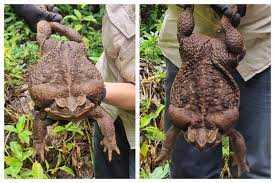
A cane toad of astonishing proportions has been discovered in a northern Australian rainforest and at a weight of 2.7kg, it could well be a record breaker, although verification is still being sought. The current Guinness World Record for the largest toad is 2.65kg, which was set by what was incredibly a pet named Prinsen, in Sweden back in 1991.
This latest find was of another giant amphibian which was around six times bigger than an average toad, and was given the nickname “Toadzilla” by wildlife officers. As is standard practice, the creature was euthanised and will soon be donated to the Queensland Museum.
Snake crossing
Park ranger Kylee Gray, explained that the “monster” was spotted by accident, when along with some co-workers out on a regular patrol, the vehicle they were travelling in was forced to stop to allow a large snake to slither across the track they had been driving on. Ms Gray noticed the toad and immediately thought it was on the large side; but after capturing it she said she could not believe her own eyes at the remarkable size of the creature.
“Toadzilla” the obvious name
She described the toad as almost like a “football with long legs” and was of the opinion that it had been around “a long time” probably devouring anything it could fit into its mouth, including all manner of insects, reptiles, birds, and even small mammals. Apparently “Connie” was the initial name given to the spectacular find, but on further careful consideration it was changed to a more appropriate “Toadzilla”, with a nod towards the fictional Japanese monster, Godzilla.
Introduced with a specific task to undertake
Native to South America and mainland Central America, the cane toad was first introduced into the state of Queensland way back in 1935 for the purpose of controlling the cane beetle population, after authorities were impressed with how they had successfully been able to see-off nuisance grubs, which had been devastating crops on Puerto Rican plantations.
One of the worst invasive species anywhere
However, that decision would soon become regrettable, as not only did they fail in their intended mission, but they became one of the worst invasive species, not only in Australia, but anywhere in the world. With no natural predators or parasites in the Australian states and territories, they have evolved differences in shape and physiology, and have brought mayhem to the native animal populations, due to the deadly milky poison that they secrete from the parotid glands behind their shoulders, which can be fatal to wildlife, and has caused localised extinction in some cases.
Dogs in particular have suffered at the hands (or maybe that should be shoulders) of these “killer” creatures, as well as some of the real predators of the land, such as crocodiles and snakes.
Border crossing bad news for conservationists
By 2009 the toads had crossed the Western Australian border with the Northern Territory, which was more than 2,000km from the site of their original release, some 74 years earlier, and for conservationists it marked a dark day in a battle they had seen coming, but had hoped they could prevent.
Their numbers are estimated to be well into the hundreds of millions, possibly over a billion across the country now.
Up to 60km per year progress
The toads are known to only move in the wet seasons, but seem to manage somewhere between 50km and 60km per year. The relentless march towards the northern coastal areas is continuing with an area of wilderness in front of them, three times the size of England, and seemingly nothing to halt their progress.
Taste-aversion tactic
One idea is to try and “train” predators with a taste-aversion strategy, which involves encouraging avoidance of larger cane toads by feeding them smaller specimens, which ultimately make them quite poorly, but crucially do not kill them. Also, there are suggestions that some animals are undergoing genetic changes that leave them less susceptible to the toad’s poison.
Scavenger comes good
There is one animal however, or to be more precise one bird, which appears to have identified how to eat these poisonous toads safely – which could help bring the population back under control – and that is the much vilified… white Ibis. Among Australians, it has earned itself a reputation for being a greedy scavenger, often being referred to as a “bin chicken” and even stealing food from people’s hands.
Now though, it has been noticed that these disliked native birds have developed an ingenious method of eating one of the few creatures regarded as an even greater pervasive pest than themselves.
Clever birds carry out rinse wash
The toad’s skin contains poison which can be released when it is threatened, with the effect of causing most animals that come into contact with it, to die quickly of heart failure. Emily Vincent
who runs the invasive species programmes at environment charity Water-gum reported that Ibis were being seen flipping the toads about, throwing them into the air, without seemingly being affected by the toxins.
Ms Vincent continued to explain that the Ibis would always either wipe the toads in the wet grass, or they would go down to a water source nearby, and they would “rinse the amphibians out”. In her own words this is an example of the birds carrying out a “stress, wash and repeat” method, to rid the toads of their poison, before swallowing them whole.
It seems that the Ibis force the toad to get rid of the toxin itself without having to mutilate it in any way. “It really is quite amusing,” she said, before adding: “Ibis do get an unfair reputation, but this clearly demonstrates that these are very clever birds.”
Record possibly never to be beaten?
If more animals cotton on to such methods then the chances are that “Toadzilla” should it be declared a record-breaker, will retain the title, unless there is a “doppelgänger” toad, hopping around the rainforest somewhere.





0 Comments